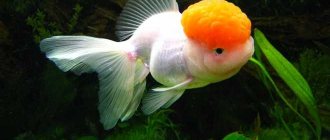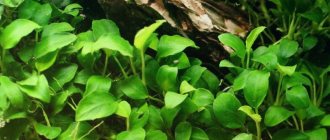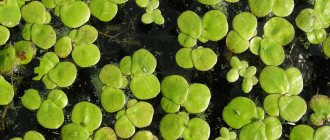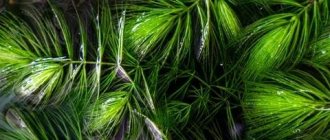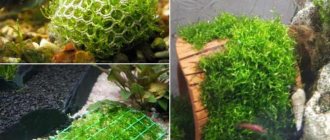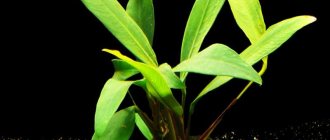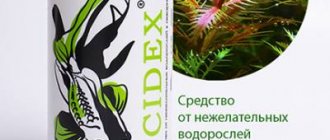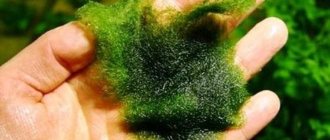Description
The water plague Elodea received its name for its rapid growth and interference with fishing and shipping. In a home pond, the plant does not require special care, improves the free space, serves as a filter, compressor, and refuge for juveniles.
If you meet elodea once, you won’t be able to confuse it with other plants!
Under natural conditions, the thin, climbing stem of water plague reaches two meters. The closer the plant is to the light, the greater the color saturation of the green fine-toothed leaves. The leaf blades are collected in a ring shape, 3 pieces per knot, which is called whorled leaf arrangement. Small, single flowers bloom when thread-like flower stalks growing from the leaf axils reach the surface. The delicate tubular calyx consists of three sepals fused together, colored greenish or reddish. The corolla consists of 3 rounded white petals.
Elodea roots are long, but thin and often poorly developed.
The roots are poorly developed. Elodea can develop in the absence of soil , floating freely in water. The rooted culture spreads along the bottom, produces multiple vertical shoots, forming lush thickets. In an indoor pond, water plague develops evenly regardless of seasonality. In nature, when the temperature drops and there is insufficient lighting, the attractiveness of the appearance is lost. The water plague sinks to the bottom of a pond or lake. As soon as conditions change for the better, new shoots grow from the preserved growth buds.
Description and features
Elodea is characterized by the presence of rhizomes, stems and leaf blades. The main stem is thin and flexible, its length is about 3 m. The lateral shoots are intertwined and have a rich green color.
Elodea leaves are curved and translucent. Their length reaches 10 mm. The root system of the plant is poorly developed, so elodea stays weak in the soil, developing mainly by floating in the aquatic environment.
The plant can either creep along the bottom of a reservoir or aquarium or rise to its surface. At home, subject to proper temperature conditions, elodea grows throughout the whole year.
Where does Elodea grow?
Elodea of the Aquaticaceae family came to Europe in the first half of the 19th century from the fresh lakes of America. The first mention of water plague in Russia, which adorned the botanical garden of St. Petersburg, dates back to 1882. Later, thanks to the rapid growth rate and unpretentiousness, the culture spread to Eastern and Western Siberia.
Thickets of elodea are not uncommon even in the middle zone.
Under natural conditions, water plague grows in stagnant, slowly flowing waters of canals, rivers, lakes, and ditches. Under favorable conditions, it depresses and displaces native aquaflora.
In Russia, elodea often forms dense thickets in small ponds, and it is not for nothing that its other name is pond snail.
The plant quickly adapts to the aquarium. Unpretentious to hardness and acid-base balance of water. The temperature for normal development is 14-24°C ; it languishes in tropical tanks.
Elodea canadensis or Water plague (Elodea canadensis)
The next step after purchasing an aquarium is to fill it with vegetation. One of the most common options is Elodea canada or water plague. This is a perennial plant from the Aquaticaceae family. This plant can grow without soil. This is especially true for temporary aquariums.
Origin
Elodea is native to Canada and the USA. In North America, it appeared in weakly flowing and stagnant bodies of water. Europeans became acquainted with this plant in the 19th century, quite by accident. Elodea canadensis quickly gained popularity on the European continent, spreading across water bodies. The first European country in which this plant appeared was Ireland. Due to the very rapid spread of elodea, the common people began to call it water plague. This plant is also found in Russia, in particular in the Moscow region. Sometimes situations even arose when Canadian Elodea interfered with the movement of ships.
The scope of application of this plant is varied. Thus, Canadian elodea is used as fertilizer, as well as feed for some farm animals. The choice of this plant in some cases is due to the fact that it grows quickly and, in bright light, grows to a large mass. This plant accumulates metal deposits and radionuclides, therefore it is used as a material for research. In addition, Elodea leaves are used to study plant cells in school and college programs.
What is Elodea? Its pros and cons
One of the most obvious advantages of Canadian Elodea is that it is not at all demanding on water quality. This plant can grow in both hard and soft water. Just be careful when changing the water quality for one plant.
The most comfortable water temperature for the growth of water plague is 16-240C. At higher temperatures it grows much worse.
Externally, Elodea Canadiana appears as curly, long and fragile shoots, parts of which are carried away by the current (this is how Elodea reproduces). The plant produces long roots that become embedded in the soil. The color of the plant is bright, rich green. The length of elodea stems often reaches 2 and even 3 m. The stems are flexible, the roots are poorly developed.
There are female and male water plague plants. The plant begins to bloom only in a suitable environment. The female flowers have 3 outer and 3 inner petals and a red-pink stigma. The 3 sepals have green and red shades. There are 9 anthers on the flowers of the male individual.
In Russia and Europe, male specimens of this plant are practically never found. In aquariums it reproduces by cuttings. For rapid plant growth, the cutting must be at least 20-25 cm long. If there are fish in an aquarium filled with Elodea canadiana, the plant will not need to be fed. Elodea feeds on animal waste products. In the presence of bright light, the plant quickly enriches the water with oxygen.
Water plague prevents the growth of algae in the aquarium by absorbing organic matter from the water and releasing harmful substances into it. There is an opinion that elodea juice is so toxic that if it gets into the water, it will destroy the fry. However, this has not yet happened, so this statement is not a verified fact. This plant is capable of absorbing some of the turbidity from the aquarium, but despite this, Elodea cannot be used as a filter: when it becomes dirty, the plant begins to grow worse and loses its aesthetic qualities. For year-round growth of elodea, good additional lighting is required. To treat aquarium fish, sometimes salt is added to the water - this has a detrimental effect on the growth and development of the plant.
Types of Elodea
There are 4 types of this plant. Elodea foliage is the most popular species that is sold in almost any pet store. This is a voluminous plant that grows into dense thickets. The basal color is green with a brown tint.
Elodea serrata is another popular plant species. It is less voluminous in shape and, even when it grows greatly, as a rule, does not interfere with the access of light to the water. Most often, this type of elodea is purchased for small aquariums in which voluminous thickets are unacceptable.
Elodea densa - as a rule, is planted in bunches of 10-15 branches. Elodea densa has a rich green color and grows densely. The leaves are less dense than those of Elodea foliage. Elodea canadensis is a common species that can grow in aquariums filled with water of different temperatures.
Care
This plant is quite unpretentious. Elodea can only grow in fresh water; it dies in salt water. The optimal temperature for growth and reproduction is room temperature (20−250C). At higher water temperatures, plant growth will slow down or stop. Water hardness, as a rule, does not matter; however, a sudden change in hardness can damage the plant.
Successful cultivation of elodea is highly dependent on lighting. Light should penetrate well into the aquarium from all sides. Lack of lighting in some areas can lead to their rotting and falling off.
In winter, elodea almost stops growing, and reduced lighting can lead to the death of the plant. It is important to provide access to light from artificial lighting sources, and so that the light penetrates the water layers evenly. The water must be clean and filtered regularly. This is due to the fact that dregs accumulate on the plant, which can greatly harm the aesthetic qualities of elodea. Installing a filter pump or washing the plant under running water will help you cope with this.
Water plague does not require additional feeding, since it feeds on waste products of aquarium animals, converting them into nutrients.
Under what conditions does Elodea canadensis grow?
The plant requires standing or slowly flowing water. Used as a plant to fill aquariums or small artificial ponds in gardens. The main functions of elodea are filtering water, saturating it with oxygen, preventing water from blooming, as well as landscaping aquariums and ponds. It is advisable that the water temperature does not exceed 200C. Elodea can grow from a depth of 20 cm to 3 m. Both natural and artificial lighting are suitable, but sunlight that evenly penetrates all layers of water is preferable. Elodea is easily accepted in the aquarium. The most important requirement for successful propagation is reliable anchorage in the soil with lime. In summer, the room in which elodea is grown should be in partial shade, in winter it should be brightly lit from above - so that the light penetrates all layers of water, into every corner of the aquarium.
Practical benefits
Elodea canadensis is used as a natural cleaner for aquariums and ponds, in order to saturate the soil with oxygen and decorate the pond with islands of greenery. Elodea can only be grown in small reservoirs (since it grows and reproduces very quickly, and it will subsequently be very difficult to clean a large reservoir of it) and in aquariums. The plant is used as fertilizer and as livestock feed.
Reproduction methods
Elodea reproduces very quickly. The side branches break off and give life to a new plant. In addition, the plant can reproduce vegetatively. To propagate elodea, you can throw a branch into the water, the length of which does not exceed 20 cm, or secure this branch at the bottom to a depth of 70 cm. It is better to secure the branches in a bunch of no more than 10 pieces. Planting is best done at the end of May. In the future, the plant will grow extensively on its own. The rapid spread of Elodea is one of its key features. So, just one branch of this plant after a few years can fill an entire body of water - a pond or river.
Diseases
By itself, this plant is not capable of getting sick. This is one of the reasons for the high popularity of Elodea as an aquarium plant. But, despite this, it should be remembered that elodea can be a carrier of diseases. So, if a plant is taken from a body of water, various infections can be brought with it. In this regard, it is best to purchase Elodea from a pet store with good reviews.
The plant dies if table salt or iron oxide gets into the water. Elodea canadensis or Water plague (Elodea canadensis) is an unpretentious plant that performs a lot of practical and aesthetic functions, and therefore is actively used to fill aquariums and small reservoirs. Caring for this plant is not difficult, but it requires responsibility. Thanks to Elodea, the aquarium is filled with beautiful greenery. It will be an excellent neighbor for hornwort, water hyacinth, etc. Due to its good adaptability to different climatic conditions and very rapid reproduction, elodea is able to grow in almost any body of water on the globe. Not only experienced professionals can handle growing elodea: even a beginner can do it. It is enough to be responsible and attentive. The result: beautiful thickets of rich emerald color and filtered, oxygenated water.
Beneficial features
The green mass of water plague is used in agriculture, increasing the fertility of the land with plant fertilizer. In livestock farming, the plant is used to feed livestock and poultry. Prudovik also left his mark in scientific research. Its leaves are used to observe the movement of the cytoplasm to determine the level of cell activity by moving chloroplasts.
Useful properties of water plague in an aquarium:
- fills empty space, decorating the tank;
- consumes nitrogenous compounds;
- under the influence of light, carbon dioxide is converted into oxygen;
- during photosynthesis, calcium carbonate is deposited on the leaves, which softens the water;
- shelters peace-loving fish, fry, shrimp from aggressive neighbors;
- kills harmful microorganisms;
- absorbs biological residues and decay products.
Angelfish, goldfish, tetras, and snails use water plague as a source of additional nutrition.
The plant absorbs CO2 only during daylight hours. At night, the gas concentration increases sharply, so you cannot do without an aerator.
By absorbing nutrients from the water, the pond snail suppresses the development of green algae .
Care
Caring for water plague is not difficult, but without maintaining basic conditions of maintenance, it loses its splendor and changes color from bright to faded. Elodea does not like too warm water. The optimal temperature is 16–20 degrees. The plant dies in water with a strong current, salt, and impurities of iron oxides.
Water plague needs good 10-hour light. Hardness matters when moving a pond snail from soft water to hard water where it experiences stress. To restore the volume of green mass, the light period is extended to 16 hours. The transfer in reverse order is painless.
Do not underestimate the role of lighting for the life of aquarium plants and the aquarium as a whole.
To prevent the plant from occupying the entire space, the shoots are periodically thinned out . Particularly rapid growth occurs in the summer. To create favorable conditions for neighbors, fragments of vertical branches are plucked off from the water plague. The decorative effect of the part of the plant creeping along the bottom is gradually lost. The leaves turn black, die, and require renewal.
Water plague does not need feeding. With an excessive concentration of nutrition, the plant grows excessively. To regulate the growing season, reduce the content of nitrogen and phosphorus, make a 20% replacement every 7 days.
The aquarium is equipped with a mechanical filter, which not only reduces the amount of organic matter, but also cleans the leaves of the crop from settled particles of turbidity and suspensions.
How to grow in an aquarium
Despite the whimsical nature of elodea, keeping it in an aquarium requires special attention. It is important to create optimal conditions for the plant by ensuring:
- Temperature ranges from 14 to 23 degrees. In water of higher temperature it will begin to slow down its growth, and in cold water it will begin to prepare for wintering.
- Water of any hardness. But when replanting, it is important to maintain the same rigidity that was in the old place. The plant will easily tolerate transplantation from hard water to soft water, but not vice versa. Does not like salt content in water. Therefore, when treating fish with salt, the plant should be removed.
- Clean water. Anacharis does not tolerate turbid water, which prevents sunlight from reaching its leaves. This can even lead to death.
- Bright and uniform lighting. From lack of light, the anacharis will first turn brown, and then drop its leaves and die. It can withstand both strong sun and moderate shade. Needs light for 10-12 hours.
- Slow flow of the aquarium. In the case of fast Elodea canada, it will simply concentrate in one corner. It doesn't look nice.
In addition, this type of aquarium plants does not require fertilizers, as it processes the waste of fish into nutrients.
Breeding and planting
Since only female specimens came from America to Eurasia, the water plague does not form a seed pod and differs from the American representatives of the genus in fragmentary, vegetative reproduction. Particles of the plant are transported over long distances by waterfowl and in rivers by currents.
The first time water plague is planted in an aquarium, taking into account the hardness of the water in which it was kept. At the end of May, a third of the upper part of the stem, up to 20 cm long, is cut off. The lower part of the elodea is grabbed with tweezers and buried 2 cm in coarse sand in a vertical position.
To prevent the cutting from floating, it is pressed to the bottom with a plastic pin, paper clip or small stone. Water plague takes root faster in silty soil, forming thin, branched roots.
If you need to plant several plants, maintain a distance of 1 cm or more between them. Tall shoots are placed in the background, low ones closer to the center. Eye-catching compositions are created when water plague is planted together with lacrimosa plants and different types of pinnate.
Vegetative propagation = cuttings. Each cutting becomes a separate plant, capable of further reproduction.
The pond fish is also propagated in another way, by lowering fragments into water, without the participation of soil. In this case, after growth, the plant covers the surface with a continuous carpet, blocking the access of light to other representatives of aquaflora and fish. To prevent this from happening, when starting up the aquarium for the first time, pour a minimum amount of water. After the roots form, water plague takes root on its own.
Kinds
Popular types of Elodea for breeding in an aquarium:
Canadian (Elodea canadensis)
The plant with a long cord-like stem and small elongated translucent leaves is unpretentious and loves cool water from 12 °C. At the top, the ovoid, curly leaves are brighter than the finely serrated leaves at the bottom. The distribution area of the Canadian Elodea in Russia is from the European part to Lake Baikal.
Water plague grows in a wide range of hardness and acidity values - 2–21°dGH, 5.0–8.0 pH. Loves bright light and direct sunlight. Fluorescent lamps are used for artificial lighting. The power of the devices is selected taking into account the conditions of the other inhabitants of the tank.
The pond snail grows at a rapid pace, free-floating or rooted in the ground. Without pruning, water plague disrupts the composition and balance of the biosystem.
Serrated (Elodea densa)
Elodea dance grows quickly at water temperatures of 15–26 °C, pH 5–9. It is a plant with a stem up to 1 m long, frequent dark green leaves with denticles along the edges. After shearing, serrated elodea begins to branch more. The crop from South America grows evenly all year round, regardless of the season.
Leafy
The plant, native to Brazil, grows up to 0.5–0.7 m and blooms with white flowers in summer. Feels good in a large aquarium with moderately warm water, acidity 6–8 pH, hardness 8–20°. The stem of the densely leafed elodea is surrounded by whorls with 4–6 leaves up to 5 cm long. The peculiarity of this species is that the leaf plates with pointed or rounded tips are curved downwards, there is no dormant period.
Botanical description of elodea
Belongs to the kingdom of perennial plants, the Flowering department, the Monocot class, the order Partiscotaceae, the Aquaticaceae family and the Elodea genus. Blooms in May-July.
Elodea is well suited for aquariums. In comparison with hornwort, which does not like water devoid of organic compounds, it is unpretentious. It quickly fills free space and can grow in the absence of soil. Because of these qualities, it was called “water plague”.
Its leaves are green with pointed tips, up to 1 cm long. The stems are long and branched, brittle, covered with whorls, each of which has three leaves. They creep to the bottom and transform into shoots that create elodium thickets. They are lighter at the top than at the bottom. Their root system is poorly developed.
In autumn and winter, elodea, due to lack of light and low temperature, retains growth buds, and they spread to the ground. When natural conditions improve, it continues its life activity. In an aquarium environment, temperatures can be controlled so that the plant grows normally in both summer and winter.
Diseases
Water plague, which releases bactericidal substances into the water and is not itself susceptible to disease. The culture withers and dies due to the fault of the owners who do not comply with the conditions of detention and the rules of care.
A plant brought into an apartment from a pond or lake can cause an infection that is harmful to fish.
Elodea not only decorates the aquarium, forming dense emerald thickets, but also releases oxygen, keeps the water clean, and shelters fry in vertical shoots.
